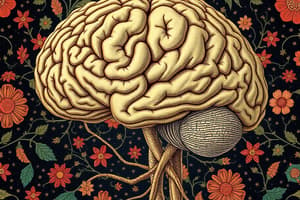Podcast
Questions and Answers
What primary role do reflex arcs serve in the nervous system?
What primary role do reflex arcs serve in the nervous system?
- To control voluntary muscle movements
- To process sensory information for the brain
- To enable quick, automatic responses (correct)
- To facilitate complex thought processes
Which part of the brain is primarily responsible for processing sensory information?
Which part of the brain is primarily responsible for processing sensory information?
- Fore-brain (correct)
- Mid-brain
- Hind-brain
- Spinal cord
Which statement accurately describes the relationship between the central nervous system and the peripheral nervous system?
Which statement accurately describes the relationship between the central nervous system and the peripheral nervous system?
- The central nervous system cannot communicate with muscles
- The peripheral nervous system facilitates communication between the central nervous system and the body (correct)
- The central nervous system exclusively controls reflex actions
- The peripheral nervous system solely processes thoughts
How does the brain contribute to decision-making about voluntary actions?
How does the brain contribute to decision-making about voluntary actions?
What role does the reflex arc play in response to touching a hot object?
What role does the reflex arc play in response to touching a hot object?
What distinguishes reflex actions from voluntary actions?
What distinguishes reflex actions from voluntary actions?
Where do the nerves that form a reflex arc primarily meet?
Where do the nerves that form a reflex arc primarily meet?
What limitation is associated with relying solely on reflex arcs for responses to stimuli?
What limitation is associated with relying solely on reflex arcs for responses to stimuli?
What is a primary advantage of reflex arcs in animals?
What is a primary advantage of reflex arcs in animals?
Why is the speed of reflex arcs crucial for survival in animals?
Why is the speed of reflex arcs crucial for survival in animals?
Flashcards are hidden until you start studying
Study Notes
Control and Coordination
- Reflex actions are rapid responses to stimuli, bypassing conscious thought
- Reflex arcs are specialized pathways in the nervous system for fast responses
- Reflex arcs connect sensory neurons directly to motor neurons in the spinal cord, enabling quick muscle activation
- Reflex arcs are more efficient than conscious reactions for immediate responses
- Complex neuron networks in the brain allow for conscious thought but are slower than reflex arcs
The Human Brain
- The spinal cord serves as a communication pathway between the brain and the body, but also plays a crucial role in reflexes
- The brain, the central processing unit, is responsible for complex thinking and voluntary actions
- The brain, along with the spinal cord, make up the central nervous system (CNS)
- The brain integrates sensory information from the body, processing it and formulating responses
- Voluntary movements are initiated and controlled by the brain
- The peripheral nervous system (PNS) consists of cranial and spinal nerves, connecting the CNS to the rest of the body
Brain Regions
- The brain has three main regions: the forebrain, midbrain, and hindbrain
- The forebrain is the most complex part, responsible for higher-level functions like thinking, learning, and memory
- Specialized areas within the forebrain process specific sensory information (e.g., vision, hearing, smell)
- Association areas integrate sensory information and past experiences to form perceptions and decisions
- Motor areas control and initiate voluntary movements, sending signals through the PNS to muscles
Nervous System Communication
- Sensory receptors located in sense organs detect stimuli
- The receptors convert stimuli into electrical impulses, which are then transmitted along neurons
- An electrical impulse travels from the dendrite to the cell body and then along the axon
- At the axon terminal, the electrical impulse triggers the release of neurotransmitters, which cross the synapse to stimulate the next neuron
- Neurotransmitters allow for the transmission of information from one neuron to another, and ultimately to muscle or gland cells
- Nervous tissue consists of neurons, specialized cells for efficiently conducting information via electrical impulses
Taste and Smell
- The sense of taste is influenced by smell
- When the nose is blocked, the ability to distinguish tastes is reduced, highlighting the connection between olfactory and gustatory receptors
- This phenomenon explains why food tastes bland during a cold or flu, when congestion affects olfactory function
Studying That Suits You
Use AI to generate personalized quizzes and flashcards to suit your learning preferences.




